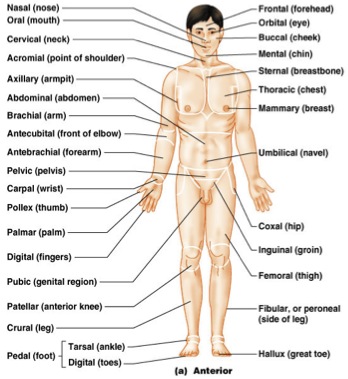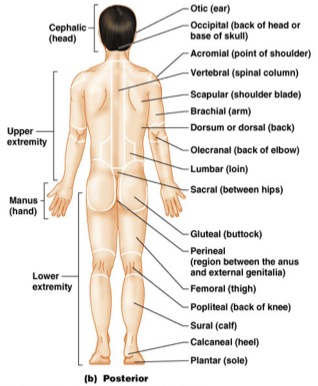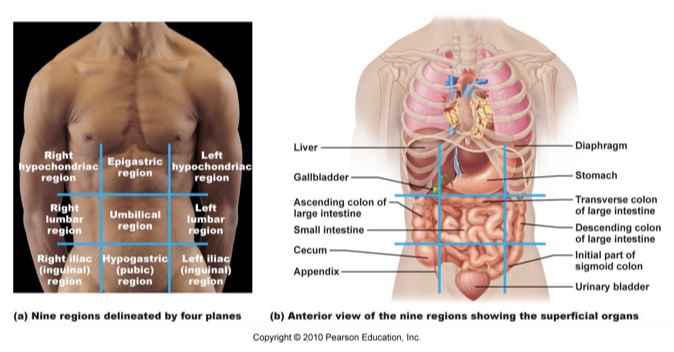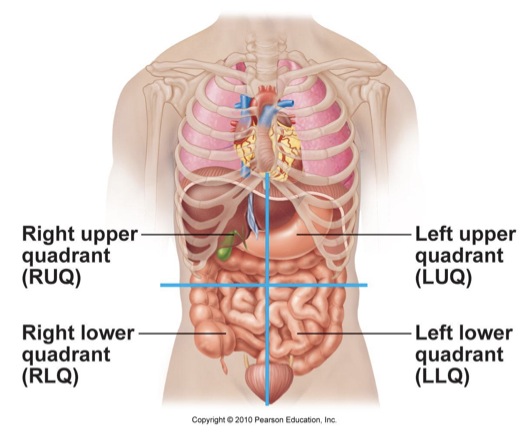|
Anatomy means... |
|
Structure (morphology) |
| |
|
Physiology means... |
|
Function |
| |
|
What is anatomical variability? |
|
Humans vary in external and internal anatomy. |
| |
|
What is palpation? |
|
Feel body surface with hands. (pulses and breathing rates) |
| |
|
What is auscultation? |
|
Listening to the internal sounds of the body, usually using a stethoscope. |
| |
What is percussion?
|
|
A method of tapping on a surface to determine the underlying structure. (abdomen and thorax) |
| |
|
What is an autopsy? |
|
Postmortem (after death) examination of the body.
|
| |
|
What is a disorder? |
|
Derangement or abnormality of function. |
| |
|
What is a disease? |
|
Illness characterized by recognizable signs and symptoms. |
| |
|
What is a sign? |
|
Objective change that one can observe and measure. |
| |
|
What is a symptom? |
|
Subjective change in body functions not apparent to observer. |
| |
|
What is a diagnosis? |
|
Distinguishing one desease from another. |
| |
|
What are the levels of organization? |
|
1) Chemical Level
2) Cellular Level
3) Tissue Level
4) Organ Level
5) System Level
6) Organismal Level
|
| |
|
What are the organ systems? |
|
1) Muscular
2) Reproductive
3) Lymphatic
4) Respiratory
5) Integumentary
6) Nervous
7) Skeletal
8) Urinary
9) Digestive
10) Endocrine
11) Cardiovascular
|
| |
|
What are the (generally accepted) necessary life functions? |
|
1) Maintain internal and external environment
2) Movement (contractility)
3) Assimilation
4) Responsiveness (irritability)
5) Digestion and absorption
6) Metabolism (anabolism/catabolism/cellular respiration)
7) Excretion
8) Reproduction
9) Circulation
10) Respiration
11) Differentiation
12) Growth
|
| |
|
What are the life survival needs? |
|
1) Nutrients (carbs, protein, fat, vitamins and minerals)
2) Oxygen (20% of "air"/oxidative reactions)
3) Water (60-80% of body weight)
4) Normal Body Temperature (chemical reactions/muscles)
5) Normal Pressures (atmospheric)
|
| |
|
What is homeostasis? |
|
To maintain a relatively stable internal environment in a changing external environment. |
| |
|
What are some features of homeostasis? |
|
1) Disruption of homeostatis can lead to disease and death
2) Requires most of the body's metabolic energy
3) Normal values for the general population are clinically important
|
| |
|
What are the 3 interdependent components of control? |
|
1) Receptor
2) Control Center
3) Effector
|
| |
|
What is a receptor? |
|
Monitors environments and responds to stimuli |
| |
|
What is a control center? |
|
Interprets signals and maintains set point |
| |
|
What is an effector? |
|
Provides a response to the stimulus. |
| |
|
What is a local disease? |
|
is an infectious process that originates in and is
confined to one organ system or general
area in the body, such as a sprained
ankle, a boil
on the hand, an abscess of finger. |
| |
|
What is a systemic disease? |
|
is one that affects a number of organs and tissues, or affects the body as a
whole |
| |
|
What is a negative feedback loop? |
|
A type of self-regulating system where increased output from the
system inhibits future production by the system. In other words,
the system controls how much product it makes by shutting down
manufacturing when levels of output or the amount of accumulated product
gets too high. Negative feedback systems are responsible for many types
of hormone regulation in the human body since they are good at
maintaining relatively constant levels of output. |
| |
|
Negative feedback mechanisms can become overwhelmed allowing what? |
|
Destructive positive feedback mechanisms to take over. |
| |
|
What is a positive feedback loop? |
|
Positive feedback loops enhance or amplify changes; this tends to move a
system away from its equilibrium state and make it more unstable and short-lived.
Examples are [normal] blood clotting and labor contractions.
|
| |
|
Intracellular fluid (ICF) is located where? |
|
Inside cells |
| |
|
Extracellular fluid (ECF) is located where? |
|
Outside cells |
| |
|
ECF is made up of what components? |
|
1) Interstitial/Intercellular/Tissue fluid (bathes and surrounds cells)
2) Plasma
|
| |
|
What are two descriptions of fluids? |
|
1) Fluids are in constant motion
2) Fluids surround all body cells
|
| |
|
What is the anatomical position? |
|
1) Standing upright
2) Facing the observer
3) Head level
4) Feet flat on the floor
5) Feet slightly apart
6) Palms forward
7) Thumbs out
|
| |
|
What are the anatomical directional terms and meanings? |
|
Anterior: In front of, front
Posterior: After, behind, following, toward the rear
Distal: Away from, farther from the origin
Proximal: Near, closer to the origin
Dorsal: Near the upper surface, toward the back
Ventral: Toward the bottom, toward the belly
Superior: Above, over
Inferior: Below, under
Lateral: Toward the side, away from the mid-line
Medial: Toward the mid-line, middle, away from the side
Cephalic: Toward the head
Caudal: Toward the back, toward the tail
Superficial: Closer to surface (skin)
Deep: Closer to bone
Peripheral:
Ipsilateral: Same side as
Contralateral: Opposite side of
|
| |
|
Know the anterior regional terms/locations. |
|

See image |
| |
|
Know the posterior regional terms/locations. |
|

See image |
| |
|
What are the planes of the body? |
|
1) Frontal (coronal, vertical)-front/back
2) Median (midsagittal, veritcal))-right/left sides thru center
3) Transverse (cross-section, horizontal)-top/bottom
|
| |
|
What are the body cavities? |
|
1) Dorsal (contains cranial cavity and vertebral canal)
2) Ventral (contains thoracic and abdominopelvic cavities)
|
| |
|
What is the difference between the parietal
and visceral membranes? |
|
Parietal membranes face an outer wall, and visceral membranes face an
inner wall. In between the membranes is a space containing serous fluid. |
| |
|
What are the 3 serous cavities of the body? |
|
The pericardial cavity (surrounding the heart), pleural cavity (surrounding the lungs) and peritoneal cavity (surrounding most organs of the abdomen. |
| |
|
What are the other body cavities? |
|
1) oral
2) digestive
3) nasal
4) orbital
5) middle ear
6) synovial (joint cavities)
|
| |
|
What are the 9 abdominopelvic regions and what organs are located within each one? |
|

See image |
| |
|
What are the abdominopelvic quadrants? |
|

See image |
| |
